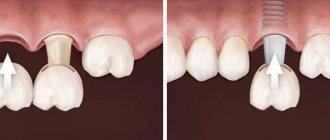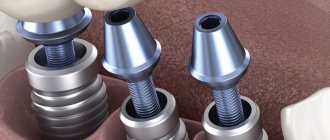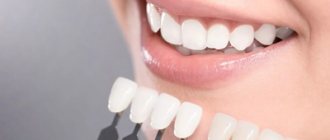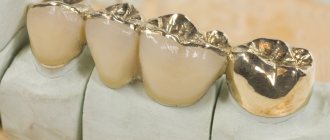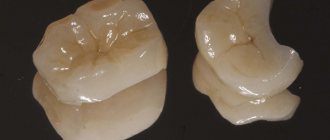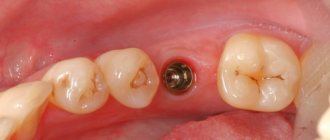Implantation has brought prosthetics to a fundamentally new level. All the disadvantages inherent in classical prosthetics have been eliminated. Stunning aesthetics are achieved, and the physiological processes of the dentofacial apparatus are restored.
What is the difference between implantation and prosthetics? The fundamental difference is that in the first case, the prosthesis is attached to dental implants, and in the case of classical prosthetics, it is attached to the patient’s living teeth. Because of this, prosthetics on implants has a number of undeniable advantages:
- The patient's healthy teeth are preserved. When installing an implant, there is no need to grind or remove the nerves of adjacent teeth.
- Reliable fixation of the prosthesis is ensured even in the case of complete absence of teeth.
- The implanted implant functions like a natural tooth, providing chewing load on the bone and thereby preventing bone tissue atrophy.
- It becomes possible to install a conditionally removable denture to replace the entire dentition or complete dental implantation using bridge prostheses.
- The service life of dentures on implants increases several times.
Removable dentures: the fastest and cheapest way to replace teeth
Removable dentures are products with a soft or hard base that imitates the mucous membrane of the oral cavity, and artificial teeth. They can be partial or complete, that is, replace a segment of the dentition or the entire jaw. A partial removable denture has special hooks - metal made of clasp wire (clasp-based denture) or plastic, which cling to the teeth, and a complete removable denture is fixed in the oral cavity due to the valve zone.
It is believed that removable dentures are now hopelessly outdated, but they have their advantages, thanks to which this solution is still in demand.
A)
Perhaps their most important advantage is the price. The cost of a removable denture depends on the material and the number of teeth being restored, however, even the most expensive removable denture costs several times less than a similar design on implants.
b)
Typically, such prostheses are manufactured within 2 weeks and do not require surgical intervention, unlike implantation. It is no secret that most patients try to avoid any surgical interventions and often choose removable dentures for this very reason.
c)
If 40-50 years ago removable dentures did not look very natural, then modern solutions (silicone removable dentures, orthopedic structures using composite teeth and individual options for coloring the base of a removable denture) can satisfy even the most demanding patient.
Cost of treatment
Sometimes a question such as “Crown or dental implant – which is better to choose?” – patients do not even consider it because they consider the installation of a root substitute to be a much more expensive procedure. At first glance, this is indeed the case. But implantation is a progressive, rational method of treatment that gives a more durable result and does not harm neighboring teeth in any way. In addition, the bridge structure for tooth restoration consists of not one, but three crowns, which reduces the cost difference between the two treatment methods. In addition, you have to bear additional costs to prepare adjacent teeth for prosthetics. Taking into account the above, the price advantage may be insignificant.
The choice of a crown on an implant or as part of a bridge to restore a lost tooth should be made together with a dentist. The specialist will suggest the best method in a given clinical situation, and the patient is left to make a decision.
Disadvantages of removable dentures
- With functionality and convenience, things are much worse. If we take the entire row of natural teeth to be 100% efficient at chewing food, then a complete removable denture (due to its design features) will allow us to achieve only 30% of the maximum capabilities.
- Another big problem with a complete removable plate denture is the unsatisfactory fixation of the prosthesis in the oral cavity. Even a properly made complete removable plate denture will not always stay well in the mouth when speaking and chewing. Also, such a prosthesis can lead to impaired diction and overlap of tactile and temperature receptors.
- A removable denture requires constant and regular correction. Food getting under the denture, the need for constant cleaning and treatment, the sensation of a foreign body in the oral cavity - this is not a complete list of problems that arise in patients who choose removable dentures.
- It is important to understand that any removable dentures without implants will not stop the process of bone tissue atrophy, which inevitably occurs after the loss of a natural tooth. Only an implantation procedure can stop bone loss.
Where to go for treatment
If you have lost one or more teeth, you are well aware of the unpleasant consequences of this loss. For many people, missing teeth is a very unpleasant experience, associated with a deterioration in appearance, the discomfort of loose dentures, pain, difficulty eating and a less active lifestyle. By choosing implants, you can solve all these problems.
The main advantages of implants:
- Implants look and function like natural teeth. Due to their design, they are firmly connected to the bone.
- Removable dentures are not comfortable, causing a lisp and slurred speech. Implants allow you to speak freely without worrying about dentures.
- Thanks to their permanent connection to the bone (osseointegration), implants eliminate the discomfort of removable dentures.
- Implants improve your smile and boost your self-confidence.
- Implants do not require grinding down other healthy teeth like denture bridges. This allows you to maintain a better level of oral health. Individual implants provide better access to interdental spaces, facilitating oral hygiene.
- The implants are made of titanium and are therefore very durable. With proper care, implants can last a lifetime.
Experts from reputable dental centers in the capital will help you decide what to choose in your specific clinical case – prosthetics or implants.
| Clinic address | Clinic | Price |
| Dentistry ROOTT |
|
| Moscow, Kolpachny lane, 6, building 4. | Dentistry Sandora |
|
| Dentistry Prosmail.RU |
|
| Moscow, metro station "Butyrskaya", Rustaveli Street, building 15 | Dental Clinic Dention |
|
| Moscow, metro station Barrikadnaya st. Zoologicheskaya, 2, under. 9 | Dentistry DENTAL DREAM |
|
| Moscow, Zvenigorodskoye sh., 7 | Dentistry Implant Expert | Nobel implantation, USA, from 50,000 rubles, Astra Tech implantation, Sweden from 47,200 rubles, OSSTEM Korea - 27,000 rubles |
| Moscow, Bolshoi Sergievsky lane, 5 | Dentistry Viva-dent | Dental implantation depending on complexity: 31,000 - 41,000 rubles per 1 tooth |
| Moscow, st. Molodtsova, 2a | Family discount dentistry | Implantation is carried out using various systems - Astra Tech (Sweden), Ankylos Densply (Germany), Dentium (Korea), the price for 1 restored tooth is from 30,000 rubles. |
| Moscow, Paveletskaya sq., 1 | Dental Clinic Denta VIP | Implantation of the IMPLA system (Germany), OSSTEM (Korea) - from 36,000 rubles. Astra Tech (Sweden) – from 45,000 rubles. |
| Moscow, st. Lyublinskaya, 161 | Dentistry PRESIDENT |
|
Possibilities of a conditionally removable denture supported by natural teeth
A fixed bridge supported by your own teeth will help replace 1 to 4 missing teeth in a row. The undoubted advantage of such dentures is a better restoration of chewing function compared to removable dentures, the absence of discomfort and good aesthetic characteristics. Bridges do not need to be maintained or adjusted: up to a certain point, the patient may not notice them at all. Of course, this design will also cost significantly less than an implant-supported prosthesis. But there are some nuances here too.
✔
With a classic bridge, only a few teeth can be restored, because the supporting teeth also need to be taken into account. For example, to replace 1 tooth, the patient is given a prosthesis on 2 supporting teeth.
✔
Abutment teeth (even completely healthy ones) must be ground down for crowns.
✔
In this case, the tissues surrounding the tooth, the so-called periodontium, have an increased chewing function, taking on the load of the missing tooth. Over a long period of operation, the reserve forces of the periodontium of the supporting teeth will weaken, which, as a consequence, sooner or later will lead to their loss. That is why the service life of bridges, as a rule, does not exceed 7-10 years.
Prosthetics or implantation - which is better to choose?
| Classic prosthetics | Implantation | |
| According to the degree of impact on neighboring teeth (supporting) | Requires preliminary depulpation and turning | Adjacent dental units are not involved |
| According to the invasiveness of the installation | Non-traumatic installation | Implants are implanted surgically - through an incision, micro-puncture of the gum or in the tooth bed after its removal |
| According to the timing of restoration of chewing ability | Limitation of functionality | Full chewing function immediately after fixation of the prosthetic structure |
| According to the degree of bone tissue atrophy | Bone loss under the prosthesis accelerates | Implants prevent bone tissue atrophy and help restore its volume |
| According to fixation reliability | May be mobile, especially if periodontal disease is present | The prosthetic system is firmly fixed to the abutments with screw fastening or cement |
| By comfort of use | Discomfort when adapting to any prosthesis. Removable designs - the entire wearing period | The orthopedic system immediately feels like your own teeth |
| Aesthetics | Relatively high | Artificial dental crowns look identical to natural ones |
| By complexity of care | More complex care | Caring for your own teeth |
What will last longer
Classic removable orthopedic systems (clasp prosthesis, acrylic structures, etc.) have a service life of 1 to 7 years. Bridge prosthesis - up to 10 years depending on the material.
Under equal conditions, a crown or bridge installed on implants will last 15-20 years. Moreover, implants last a lifetime.
Which is cheaper?
When calculating costs, you should take into account the service life of dental implants compared to classic dentures.
An option for comparison is replacing 1 lost tooth:
- installation of an implant with a metal-ceramic crown - 48,000-55,000 rubles (depending on the method of fixation).
- bridge prosthesis of 3 metal-ceramic crowns - 45,000-75,000 rubles (depending on the base material and manufacturing technique).
In 8-10 years, with a 90% probability, a new bridge will be installed; another 45-75 thousand rubles will be required, and taking into account inflation, this amount will be higher. But this is provided that the supporting teeth remain in their original condition. If it is necessary to restore abutment teeth, the price will increase further. This will reduce the savings to nothing.
Taking into account the installation of a new bridge prosthesis every 10 years, supported by abutment teeth, it turns out that implantation is cheaper and much more reliable. Implantation is done once and forever. Installing a metal-ceramic crown to replace a worn one will be required no earlier than in 15-20 years.
Thanks to protocols and latest generation materials, dental reconstruction using implantation is possible with a minimum of contraindications. It is used for patients with periodontal diseases, HIV and other complex pathologies.
Why is implant-supported prosthesis considered the best solution?
I.
The dental implant method allows you to restore lost teeth using single crowns, bridges and full dentures supported by implants. Such a prosthesis, even in the absence of all teeth, completely restores chewing function.
II.
The implant completely replaces the root of a natural tooth: it receives the load from the crown and distributes it to the bone tissue, so that it does not undergo atrophy. Simply put, with the help of dental implants, the doctor restores the natural function of chewing to the fullest extent possible. Feedback from patients about implantation, especially from those who have previously used prostheses of other designs, will be positive in the vast majority of cases.
III.
The service life of an intraosseous dental implant (if its installation was carried out efficiently) is practically unlimited. We see patients who had implants installed more than 30 years ago. Particular attention should be paid to self-discipline and compliance with all rules of oral hygiene. The patient must understand that the presence of implants increases the requirements for daily hygiene (using not only a toothbrush, but also an irrigator) and implies regular (2 times a year) professional oral hygiene. Thus, the long-term functioning of implants is not only the competent work of the doctor, but also the responsible attitude of the patient himself to his health.
How is a crown installed?
It is not always necessary to completely replace a tooth with an implant. If at least a part remains, a crown can be placed on the remains of the tooth.
Main stages:
- Treatment. The teeth are cleaned of plaque and tartar, and if necessary, nerves are removed and fillings are installed.
- Shape adjustment. The tooth on which the crown will be installed is ground down to the required size to install the prosthesis.
- Making a crown. An impression is made from the ground down tooth and a new crown is fitted to it; the whole process takes three weeks. During this period, the patient is fitted with a temporary crown.
- Fitting and correction. The finished crown is tried on the tooth; sometimes several visits to the dentist are required for a more precise fit in tone and shape.
- Fixation of the prosthesis. It is best to choose metal-ceramics or ceramics; these materials more accurately copy the color and shape of real teeth.
How many implants are needed to install a prosthesis?
➢
Restoration of several teeth. It is optimal when implants replace every lost tooth. If 3 teeth are missing, we install 3 implants and replace each implant with a separate crown. We get maximum and natural restoration of chewing function and the best aesthetic result. It is possible to install 2 implants when replacing 3 lost teeth - this is already a bridge prosthesis. The chewing function is restored completely, but restoration of ideal aesthetic parameters can be difficult, as well as hygiene.
➢
Restoration of a completely toothless jaw
- Conditionally removable and removable dentures on implants.
When rehabilitating patients with complete edentia, it is not always possible to make a fixed dental prosthesis supported by implants. With prolonged absence of teeth and when using complete removable dentures, atrophy of the alveolar process and narrowing of the dentition occur. In the absence of the required volume of bone tissue and mucous membrane of the alveolar process, especially in the lateral parts of the jaws, implants as a support for a conditionally removable denture can be installed in the front part of the jaw. The base of such a prosthesis can imitate part of the mucous membrane, which creates an additional cosmetic effect. There are different types of fixation of conditionally removable plate prostheses supported by implants: a beam fixation system, fixation of the prosthesis on ball-shaped abutments, a telescopic system, etc. - Fixed dentures on implants.
If there is a sufficient volume of bone tissue or if teeth are removed simultaneously with the installation of implants, it is possible to manufacture permanent structures on implants. These types of dentures have all the advantages over removable and conditionally removable dentures supported by implants.
- There is no need to remove the denture from the mouth after each meal.
- Reliable fixation of crowns in the oral cavity.
- The shape and size of crowns follow the anatomical shape and size of their teeth. In this case, the chewing load is evenly transferred to the bone tissue surrounding the implants, which allows 100% of the chewing function to be restored. All this makes implant-supported fixed prostheses comfortable and convenient for the patient, so adaptation to such designs occurs as quickly as possible.
In case of complete loss of teeth, prosthetics on dental implants can be carried out in different options.
- “All on 4” is the most gentle technique with the installation of 4 implants and fixation of a fixed prosthesis on them. Surgical intervention in this case is minimal and is carried out using a special surgical template through a puncture of the mucous membrane in the area where the implant is installed.
- Installation of 6-8 implants and subsequent prosthetics with a fixed prosthesis made of metal ceramics and zirconium dioxide.
- Installation of 8 or more implants and fixation of fixed bridges or single crowns made of metal ceramics or zirconium dioxide on them. Today, dentistry has entered the age of digital technology and computerization. Advanced CAD/CAM systems allow you to achieve maximum speed and accuracy in the manufacture of implant-supported orthopedic structures.
Compromises in the cost of final treatment include the choice of the option of fixed prosthetics on implants made of different materials: this is the production of metal-ceramic structures, zirconium with veneer and all-zirconium structures.
To reduce the patient’s financial costs for the manufacture of implant-supported fixed dentures for a toothless jaw, you can consider the concept of patient rehabilitation “All on 4” and “All on 6”, as well as a shortened dentition.
Requirements for dental restoration methods
When renovating, two things are important - aesthetics and functionality.
Aesthetics - the appearance of the prosthesis. It should not differ from neighboring crowns and should resemble natural ones in anatomical shape and color. If artificial gum is present, it should be invisible when smiling - the contour is thin and neat.
Functionality consists in restoring the bite - tightly closing the chewing rows and correct positioning of the jaws relative to each other. The load should be distributed evenly.
When choosing a method, take into account that prosthetics is inferior to implantation. The pressure on the supporting teeth increases, and the bone tissue under the prosthesis atrophies. Atrophy will lead to deterioration of hygiene and the risk of inflammatory processes. Implants do not have such problems. The role of the root is played by an artificial rod in the bone, so when chewing, the same force is applied to the jaw as with a healthy tooth. This type of prosthetics is better in terms of functional restoration. In terms of aesthetics, implants also benefit.
About the disadvantages of implantation
From the outside, implantation may seem like an ideal technique, and in many ways it is - with the exception of a few points. The disadvantage of implantation is not only the high price, but also limitations during the procedure. There are a number of contraindications in the presence of which dental implantation is not recommended or cannot be carried out in principle. In case of absolute contraindications, alternative methods remain the only option.
If a sufficient volume of bone tissue is preserved, prosthetics on dental implants does not present any difficulties and allows the patient to obtain the maximum expected functional result and better aesthetics.
In cases where the volume of bone tissue does not allow the installation of an implant, additional osteoplastic operations are required to restore it. In some cases, plastic surgery of the gingival margin may be required, especially if the patient has high aesthetic needs. In the postoperative period, soft tissue swelling and pain are possible.
If treatment is carried out according to the classic two-stage protocol, the implant is installed in the bone tissue, and sutures are placed on the mucous membrane above it. After surgery, the healing process (waiting for the implant to integrate into the bone) can take from several weeks to several months. Then the second stage, additional surgery, is performed. The implant is opened, the external parts are fixed on it, and the orthopedic stage of treatment begins, the manufacture of the actual dentures. Not everyone is ready to wait that long.
There are options for installing an implant during tooth extraction and immediate fixation of a temporary prosthesis on the installed implant. The choice of technique is made by the doctor, based on each specific case.
How is dental implantation performed?
Full implantation is the most expensive method of restoring teeth, but it is also the most durable and comfortable.
The procedure itself is carried out in several steps:
- Installation of a titanium rod into the bone. It is the metal rod that will play the role of the tooth root. It will take approximately 5 months for the implant to take root.
- Gum formation. Since the gums gradually begin to deform due to missing teeth, they need to be returned to their previous shape before a crown is placed on top. Sometimes this procedure is performed immediately during implantation, but most often several months or six months after it.
- Abutment installation. This small design allows you to install the prosthesis itself on the implant.
- Crown installation. The final stage of the procedure.
What affects the cost of the procedure:
- crown material;
- country of origin of the implant;
- abutment cost;
- number of teeth that need to be replaced.
The final amount also includes the doctor’s work and the selection of a crown to suit the individual characteristics of the patient. Many people are scared by the price of implantation, but this is the only way to restore teeth so that they are as similar as possible to real teeth in terms of convenience and appearance.
About implant brands and price differences
The most expensive implants are those made in Europe and the USA, but this does not mean that they have no alternative. We recommend paying attention to South Korean implants. Many are quite skeptical about products from Asia, but the medical industry of South Korea is not inferior to leading Western countries in terms of technological solutions. One of the best South Korean implant systems is Osstem. The company offers a wide range of implants and abutments that can solve the problem of partial and complete tooth loss in patients of various age and social groups. The possibility of 3D planning and the availability of special sets of tools for installing Osstem implants in conditions of bone deficiency makes it universal.
It is very important that the selected company producing implants has a distributor in your city who would not only sell this system, but also conduct courses, seminars, master classes and provide all the necessary technical support to doctors and patients. There is no need to save on your health by trusting systems that have not received a license and do not have official representation in Russia.
What are the dangers of long-term absence of teeth?
The loss of one or several teeth at once is not only unaesthetic, but also entails a number of problems for the health of the entire jaw apparatus. The following are undesirable consequences that can result from prolonged toothlessness:
- elements adjacent to the defect tend to fill the free space in the row, which is why they gradually change their position. All this negatively affects the distribution of the chewing load, leads to bite deformation, rapid destruction of healthy units, problems with the functioning of the masticatory muscles and jaw joint,
- the risk of developing gum disease increases. This is facilitated by resorption of the jaw bone in the area of the defect, due to which the soft tissues change their relief and sag noticeably, which also affects the aesthetics of the smile,
- Digestive problems and problems with the functioning of the stomach and intestines appear. The thing is that even partial adentia affects the quality of chewing food. Food is less easily crushed and processed by saliva, which places increased strain on the pancreas and stomach,
- speech is distorted, defects appear in the pronunciation of individual sounds,
- Facial features are deformed, especially when a large number of teeth are missing at once. You can often observe a visual reduction in the lower third of the face and drooping corners of the mouth. At the same time, the nasolabial folds become more pronounced and deeper, which overall noticeably ages the face,
- Serious psychological complexes appear, especially when the patient has no front teeth. Self-esteem and self-confidence suffer greatly. A person tries to avoid communication and becomes withdrawn.
It is not at all necessary that the problems described above will make themselves felt immediately after tooth loss. However, over time, if no measures are taken, such phenomena can significantly complicate life.
The role of the doctor in choosing a treatment method
Often, already at the first consultation, the patient categorically declares: “I need an implant!” It sounds so confident that it seems that only the lack of appropriate tools is keeping the patient from doing it himself.
Before receiving the right to treat patients, a doctor studies for 6 years, then for 2 years he can undergo highly specialized training. Every 5 years he goes to improve his qualifications, but in fact he studies all his life, constantly gaining new experience, skills and knowledge. What can be concluded? Only a doctor can draw up an optimal rehabilitation plan and carry out the necessary manipulations.
Before starting treatment, a comprehensive clinical and radiological examination is carried out, and if necessary, the patient is referred for consultations to doctors of related specialties. Not only the extent of the dental defect is assessed, but also the condition of each remaining tooth, the quantity and quality of bone tissue, and the presence and severity of the patient’s general diseases. Only then will it be possible to make a diagnosis and formulate a treatment plan. Of course, the patient should be fully informed about both the treatment plan and alternative methods.
In conclusion, we would like to advise patients who have not decided on the choice of treatment method and who have no serious contraindications to pay attention to dental implants.
Indications for dental prosthetics
Indications for traditional dental prosthetics and implantation are the same:
- Single or multiple dentition defects included.
- Absence of outer teeth in a row.
- Complete edentia of one or both jaws.
Not so long ago, there was a wide range of absolute contraindications to implantation. Improvements in implantation protocols today have reduced this list to just a few items. Most contraindications are eliminated at the preparatory stage for implantation.
Which crown is better to choose for an implant?
A metal-ceramic crown is an excellent option for chewing teeth. If prosthetics on implants is carried out in the frontal zone of the smile, then it is better to give preference to zirconium crowns and, accordingly, zirconium abutments. Zirconium dioxide crowns are translucent and look natural. In the case of metal-ceramics, it is possible for metal to penetrate through the gum.
How is dentures performed?
Fixed and removable dental prosthetics includes the following stages:
- Preparatory
A thorough preparation of the oral cavity is carried out - current problems with teeth and gums are eliminated, preliminary orthodontic treatment is carried out (bite correction, etc.). If permanent dentures with veneers or lumineers are planned, teeth whitening is required. To securely fix a crown or dental bridge, depulpation and grinding of the supporting teeth are required. The dentist makes a decision about the need to depulpate a tooth based on the diagnostic results.
- Manufacturing of dentures
In a dental laboratory, an orthopedic system is made using individual impressions from the patient’s teeth.
- Installation
During fitting, the finished orthopedic system is adjusted to the required parameters, the shade and texture of the artificial teeth are adjusted, and the prosthesis is finally fixed in the mouth.
When implantation is contraindicated
Dental prosthetics on implants is not performed in the following cases:
- gross pathologies of organs and systems;
- immunodeficiencies of various nature;
- taking immunosuppressive therapy for organ and tissue transplantation;
- oncological diseases;
- allergies to drugs and materials used during surgery;
- pathologies of bone tissue (congenital, acquired);
- mental illness.
The doctor cannot agree to surgery if there is the slightest risk of implant failure or complications in the long term. Other contraindications include pregnancy, children under 18 years of age, exacerbation of chronic diseases of an infectious or non-infectious nature. In this case, doctors at the Vimontale clinic offer options for removable or permanent prosthetics without implantation.
Delayed prosthetics on implants.
From the point of view of predicting the success of implantation, this technique is considered the safest. Especially if a two-stage implantation is carried out: during the healing period of the implant, it is tightly sutured under the gum for a healing period of 3 to 6 months. In this case, the entry of microbes and bacteria into the implanted area is excluded and the implant fuses with the bone without the risk of harmful microorganisms. Even accidental chewing movements on the healing implant are also excluded. The disadvantage here is the lack of aesthetics during the period of osseointegration and repeated surgical intervention after a certain time. When you need to open access to the implant and install a gum former on it.
With one-stage dental implantation, the former is installed immediately. The advantages are the absence of additional surgical intervention after implant integration and time savings of 3 weeks (the period of stay with the gum former).
